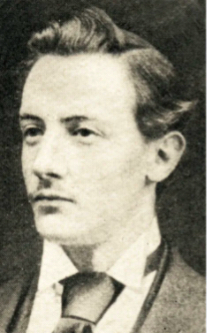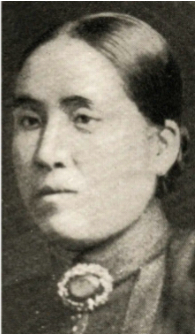
George Parker joined the CIM as one of “The Eighteen” for whom Taylor and his coworkers had been praying for more than a year. Taylor had requested that people ask God to raise up “eighteen” men to engage in pioneer evangelism in the nine provinces of China still entirely unreached by the gospel. Defying what seemed to be all prudential considerations, Hudson Taylor forged ahead with his vision to send Christian missionaries to every province of China. Others had already reached the field when Parker and several others sailed from England in early 1876, arriving in May of that year.
In December, he and George F. Easten set out with two other CIM workers, George King and Charles Budd. They traveled with two Chinese Christians from Zhenjiang named only as Yao and Zhang, who were to travel widely in Shaanxi, while Easten and Parker headed for Lanzhou, Gansu, with a Zhenjiang man named Zhen and an evangelist named Zhang. “Altogether they left the Han River above Laohekou at the end of February and hired baggage and riding mules for the mountain journey to Xi’an, preaching and selling books in every town and market they passed through. While the novice missionaries could do little themselves, they listened and learned all the time from the evangelists, and soon were carrying a full share of the work. ‘The roads are shockingly bad; we have walked the whole distance, about 22 miles,’ Easton wrote” (Broomhall 6.79). Everywhere, they saw the imperial edict guaranteeing free passage to foreigners.
At Xi’an, the party split up, with the Gansu team going on, entering the province on December 28. There they “met with large audiences of well-behaved people to whom not only the gospel but the common terms for God and religious ideas seemed entirely new. But if the number of books they bought gave a clue they seemed interested” (Broomhall 6.81). In one town “they were almost mobbed for books” (Broomhall 6.81). Arriving in Lanzhou, they found that the Roman Catholics had two places of worship, with at least one priest. Reading their report, Hudson Taylor lamented that the “gospel of justification by faith in Christ and his finished work of atonement for sinners who believe, unobscured by Roman accretions” had not yet been preached there (Broomhall 6.81).
Easten and Parker traveled in Shaanxi and Gansu, returning to Wuhan in January, 1878, having been preceded by King and Budd, but each said that they could no longer work together again. Happily, by September they had sorted out their differences and set out for the northwestern provinces again. After a five month journey, they arrived in Lanzhou and then settled in Tianshui. Leaving Easten there, Parker joined up with Budd to attempt to enter Xi’an, until they were forced out by a Mandarin. They worked from a boat for several months.
In 1881, George Parker took Easten’s place in the town of Tianshui, a strategic location on a major trade route between Lanzhou and Xi’an. “Although he had a full schedule reaching out to the unreached Han Chinese and Hui Muslims in the city of Lanzhou, he nevertheless found time to conduct extensive journeys throughout the Amdo area” of Tibet (Hattaway 52).
A Path-Breaking Marriage

George Parker had joined the China Inland Mission as a single man. While studying Chinese at the language school for men, he met a teenaged Chinese girl, Shao Mianzi, who was a student at the girls school operated by the CIM. Their friendship blossomed into love and the couple declared their desire to get married.
Hudson Taylor was in England when letters began arriving from missionaries who objected to the union. Mianzi was “a fine girl, intelligent and active as a Christian, well suited to be a pastor’s wife in a year or two. But Parker was determined to marry her, and nowhere is it suggested that the wish was not mutual.” Parker’s mother was “in tears, pleading that he should change his mind for several practical reasons. Chinese culture, attitudes and family ties were so widely different from European ones in those days that many marriages between the races foundered over the inability of partners to adapt to each other” (Broomhall 6.247). Marriage is difficult enough without adding cultural barriers.
“No object was raised to an inter-racial marriage per se. Yet even adaptation was a minor matter beside the fact that” Hudson Taylor had solemnly promised her father that Mianzi would be married to a Chinese Christian man and not to a foreigner. To renege on this promise would be to ruin the credibility of the Mission.
The young couple insisted, however, and a furor ensued in the CIM. Some were afraid that if Mianzi were allowed to marry Parker, Chinese parents would be reluctant to send their daughters to Christian schools. After much correspondence and intense conversations, the girl’s father offered a compromise: He would accept payment for the expense of bringing her up and, in return, sign a document consenting to the marriage.
The wedding took place in 1881, and “Minnie” Shao Parker became the first Asian to join the CIM, a forerunner of many since her time. We should note that while some Chinese have sensed racism in this affair, there was never any question whether it was right to marry a Chinese girl; the only problem was how to fulfill the solemn commitment that had been made to her father.
The couple set up housekeeping in Tianshui, accompanied by Miss Elizabeth Wilson, an older single CIM missionary. “She and ‘Minnie’ took Tianshui by storm, visiting the women in their homes, especially after Minnie’s first child ‘Johnnie’ was born” (Broomhall 6.249). Wilson had to leave, but she was replaced by Miss Hannah Jones, whose arrival set Parker free to take a five-month journey through northeastern Gansu and Ningxia. Pioneering was in his blood. Hardly had he reached home than he swept his wife and Hannah Jones away, to “take the gospel to Tibetan women and mandarins’ wives on the Qinghai border” (Broomhall 6.249).
Leaving Minnie and Hannah at an inn, Parker himself went on to Labrang now Xiahe, only inferior to Lhasa, and to Huozhou (or Hezhou) “the most important Mohammedan centre in China.” Welcomed at each place, he was rebuked for not bringing Arabic Bibles. “I could have sold large numbers of Arabic and Persian Scriptures,” he wrote in his diary, “but few read Chinese.” They returned to Tianshui on September 26, completing a distance of one thousand miles in seventy-eight days, roughly the same time and distance as on another of his journeys. He had sold 25 complete Bibles, 183 New Testaments, 685 “quarter Testaments” (a Gospel, Acts and some epistles) and 5,732 single Gospels, and was asked for more in different languages (Broomhall 6.249).
These long journeys by Parker and other CIM missionaries had several purposes: To become familiar with these unopened provinces and to find suitable locations for a settled ministry by later missionaries, to distribute literature that would reach far beyond the personal presence and spoken word, and generally to sow seeds of the gospel in order to prepare the inhabitants to receive the new workers that Taylor hoped would soon “occupy” – that is, live in – all the provinces of China.
We should note that Taylor did not believe in so-called “blitz evangelism,” as critics then and now have charged. Rather, he followed a careful strategy of working from the outer perimeter of cities in ever-narrowing circles, creating an awareness of the gospel and familiarity with Western missionaries, until they could establish a settled work in major towns.
In 1883, “the Parkers set off on a 2,000-mile exploratory journey through southern Gansu, riding through regions under the control of the Choni Tibetan prince. Minnie proved a great asset to the ministry, while her dark complexion helped her easily [to] fit in with the local Tibetan women” (Hattaway 53). Parker was able to leave Minnie and their coworker Miss Jones in Choni while he traveled on. “In Choni, Mrs. Parker and Miss Jones mixed freely with the Tibetan women, and also visited the wives of some of the principal residents who were in positions of authority,” sharing the gospel with people who had never heard of Jesus before (Hattaway 54).
George and Minnie lived in a house outside of Lanzhou. Parker was finally able to secure rented premises in Lanzhou, the capital of Gansu, in 1883. Two more CIM workers would live there later. Taylor then began to look beyond China proper to the regions beyond. Parker, a pioneer at heart, was more than eager to be part of any new advance.
On January 27, 1887, Hudson Taylor told his deputy John Stevenson “that the Parkers proposed moving 500 miles farther west to Suzhou (now Jiuquan) in March with a minimum of baggage. From there George was to go 600 miles even deeper into Xinjiang to Urumqi (Dihua), the heart of Chinese Turkestan, to prepare a place for his family to come in the spring of 1888. They would be more than thirty-five day stages from the nearest other member of the Mission. During 1888-1889 he was to travel among the Turki Uigurs south of Aksu, almost to Kashgar, and northwards among the Mongols beyond Lake Barkul. On this venture he would come close to the Russian border” (Broomhall 7.47).
During this stage of their missionary career, George concentrated on northwest China. Minnie went with him as they engaged in evangelism and Bible selling on the journey described just above. They arrived in London on March 11, 1890 after a year-long trip. Later in life they reached out to the Muslims of Henan (Broomhall 7.49).
The Parkers served in China together for the rest of their lives. He returned to England only twice, in 1890 and 1907. They lost all their possessions at least twice by looting (in 1900 and 1914). During the Boxer rebellion, when the Empress Dowager ordered the death of all foreigners, Parker “was shown the edict to kill and then given a running start to safety only just ahead of his pursuers” (Broomhall 7.453). Shortly after they celebrated their 50th wedding anniversary in 1931, George passed away after a ministry of 55 years in China. At the time, he was the “doyen” of active members of the CIM, and Minnie was after his death the most senior. She had eight children. She and her son returned to England; he later became Chief Engineer for the London Railway. Their son served on the London Council and their daughter, “Mrs. Mason, became as good a missionary as her mother” (Broomhall 6.251).
Minnie died in Yantai, Shandong, in 1940.
“Only eternity will reveal the impact that the early ministry of the Parkers and other missionaries had for the kingdom of God among the Amdo Tibetans. In the same town, Choni, that they frequently visited, a strong church emerged a few decades later, which grew to become one of the largest Evangelical fellowships of Tibetan believers anywhere in the world to the present time” (Hattaway 54).
G. Wright Doyle
Sources
Broomhall, A.J. Hudson Taylor and China’s Open Century. Sevenoaks, UK: Hodder & Stoughton and Overseas Missionary Fellowship.
Book Six: Assault on the Nine, 1988.
Book Seven: “It Is Not Death to Die!” 1989.
Hattaway, Paul. Tibet: The Roof of the World. Vol 4. In the China Chronicles series. London: SPCK, 2020.
